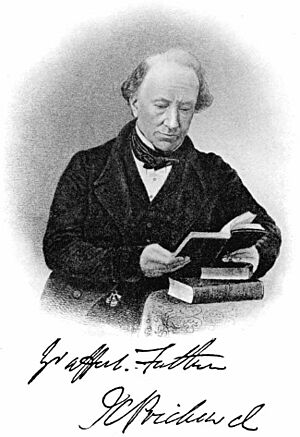James Cowles Prichard facts for kids
James Cowles Prichard (born February 11, 1786 – died December 23, 1848) was an important British doctor and scientist. He was interested in many things, like how humans developed and how the mind works. He was a physician (doctor) and an ethnologist, which means he studied different human groups and their cultures.
His famous book, Researches into the Physical History of Mankind, talked about how humans have changed over time. Later in his life, from 1845, Prichard worked as a Medical Commissioner in Lunacy. This role involved overseeing mental hospitals. He also created the term "senile dementia", which describes memory and thinking problems in older people.
Contents
Early Life and Education
James Cowles Prichard was born in Ross-on-Wye, Herefordshire, England. His parents, Thomas and Mary Prichard, were Quakers. Quakers are a Christian group known for their simple lifestyle and peaceful beliefs.
When James was young, his family moved to Bristol. His father worked in an iron factory there. James was mostly taught at home by his father and other teachers. He learned many subjects, including different languages.
Choosing a Medical Career
James did not want to work in the iron factory like his father. Instead, he decided to become a doctor. This was a bit tricky because, as a Quaker, he couldn't easily join the main medical colleges in England.
So, he started by training with other Quaker doctors. He learned about medicine in Bristol and then at St Thomas' Hospital in London. In 1805, he went to Edinburgh University in Scotland. Scottish medical schools were very respected at that time.
He earned his medical degree (M.D.) from Edinburgh in 1808. His final paper for this degree was about a big question he would study his whole life: where do different human groups and "races" come from?
Life After Edinburgh
After Edinburgh, he studied for a year at Trinity College, Cambridge. Then, he made a big personal choice: he left the Quaker faith and joined the Church of England. He also studied at Trinity College, Oxford, but he did not get a degree from either Cambridge or Oxford.
In 1810, Prichard started working as a doctor in Bristol. He became a well-known doctor at the Bristol Royal Infirmary in 1816. While working there, he wrote his important book, Researches into the Physical History of Man.
In 1845, he moved to London because he was chosen to be one of three medical Commissioners in Lunacy. Sadly, he died three years later in London from a fever. At the time of his death, he was the head of the Ethnological Society of London, a group that studied human cultures. He was also a Fellow of the Royal Society, a very respected scientific group.
Important Scientific Work
In 1813, Prichard published his book, Researches into the Physical History of Man. It was based on his earlier ideas from his university paper. This book grew over time, and by its third edition (1836-1847), it had five volumes!
The main idea of his work was that all humans belong to a single human species. He believed that different human groups, or "races", developed later due to various reasons. He thought that to understand people, you needed to look at all their features together.
Ideas on Evolution
Prichard was one of a few British scientists in the early 1800s who thought about how humans change over time. He believed that differences between human groups could be passed down from parents to children.
Some historians say that Prichard came very close to explaining how new forms of life appear through a process called natural selection. However, he never clearly stated this idea in his own words.
Interestingly, Prichard once suggested that the first humans might have looked like people from Africa. He wrote: "On the whole there are many reasons which lead us to the conclusion that the primitive stock of men were probably Negroes..." He later removed this idea from his books.
Studies of Human Cultures
Prichard was very important in the early days of ethnology and anthropology. These are fields that study human societies and cultures.
He believed that Celtic languages (like Irish or Welsh) were related to other European languages, such as German and Latin. He wrote a book in 1831 called Eastern Origin of the Celtic Nations, comparing Celtic words with Sanskrit (an ancient Indian language).
In 1843, Prichard published Natural History of Man. In this book, he again stressed his belief that all humans are one species. He pointed out that all human groups share the same inner thoughts and feelings. Prichard was also an early member of the Aborigines' Protection Society, a group that worked to protect native peoples.
Work in Psychiatry
Prichard also specialized in what we now call psychiatry, which is the study and treatment of mental health.
In 1835, he published A Treatise on Insanity and Other Disorders Affecting the Mind. In this book, he talked about a specific mental health condition he called "moral insanity". This was a new idea at the time. It described people who seemed to know right from wrong but couldn't control their actions or feelings.
His work also gave the first clear definition of "senile dementia" in the English language. This term describes a decline in mental abilities, like memory and thinking, that happens in older age.
Family Life
James Cowles Prichard married Anne Maria Estlin. They had ten children together, and eight of them lived past infancy. Some of their children included Augustin, Constantine, Theodore, Illtiodus, Edith, and Albert.
Where to Find His Records
You can find documents about James Cowles Prichard and his son Augustin at the Bristol Archives. More records are also kept at the Wellcome Library and the Royal Geographical Society.


